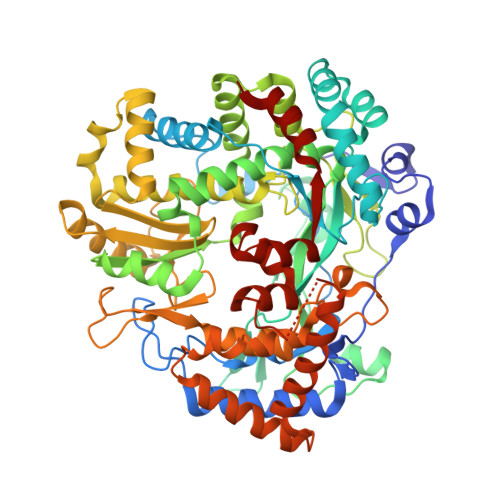Structural Explanation for the Role of Mn2+ in the Activity of {Phi}6 RNA-Dependent RNA Polymerase.
Poranen, M.M., Salgado, P.S., Koivunen, M.R.L., Wright, S., Bamford, D.H., Stuart, D.I., Grimes, J.M.(2008) Nucleic Acids Res 36: 6633
- PubMed: 18940872
- DOI: https://doi.org/10.1093/nar/gkn632
- Primary Citation of Related Structures:
2JL9, 2JLF, 2JLG - PubMed Abstract:
The biological role of manganese (Mn(2+)) has been a long-standing puzzle, since at low concentrations it activates several polymerases whilst at higher concentrations it inhibits. Viral RNA polymerases possess a common architecture, reminiscent of a closed right hand. The RNA-dependent RNA polymerase (RdRp) of bacteriophage 6 is one of the best understood examples of this important class of polymerases. We have probed the role of Mn(2+) by biochemical, biophysical and structural analyses of the wild-type enzyme and of a mutant form with an altered Mn(2+)-binding site (E491 to Q). The E491Q mutant has much reduced affinity for Mn(2+), reduced RNA binding and a compromised elongation rate. Loss of Mn(2+) binding structurally stabilizes the enzyme. These data and a re-examination of the structures of other viral RNA polymerases clarify the role of manganese in the activation of polymerization: Mn(2+) coordination of a catalytic aspartate is necessary to allow the active site to properly engage with the triphosphates of the incoming NTPs. The structural flexibility caused by Mn(2+) is also important for the enzyme dynamics, explaining the requirement for manganese throughout RNA polymerization.
Organizational Affiliation:
Institute of Biotechnology and Department of Biological and Environmental Sciences, Viikki Biocenter, P.O. Box 56 (Viikinkaari 5) 00014 University of Helsinki, Finland.















